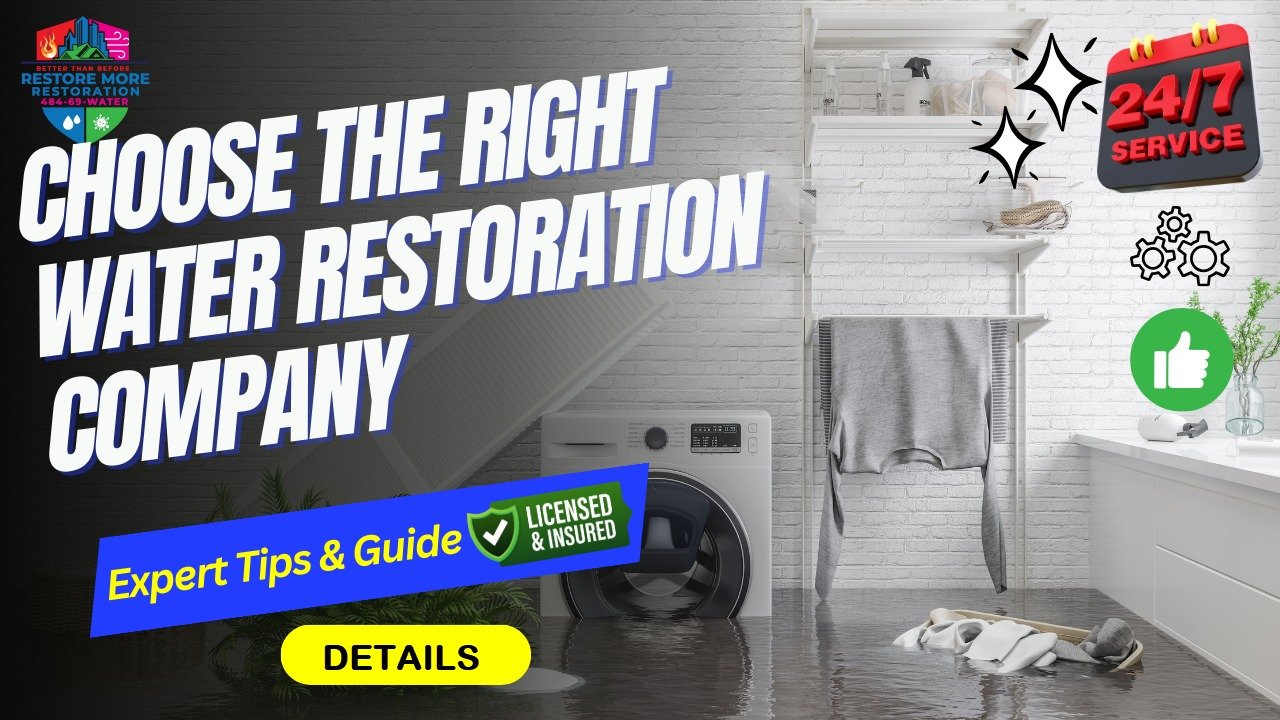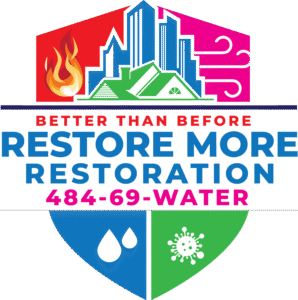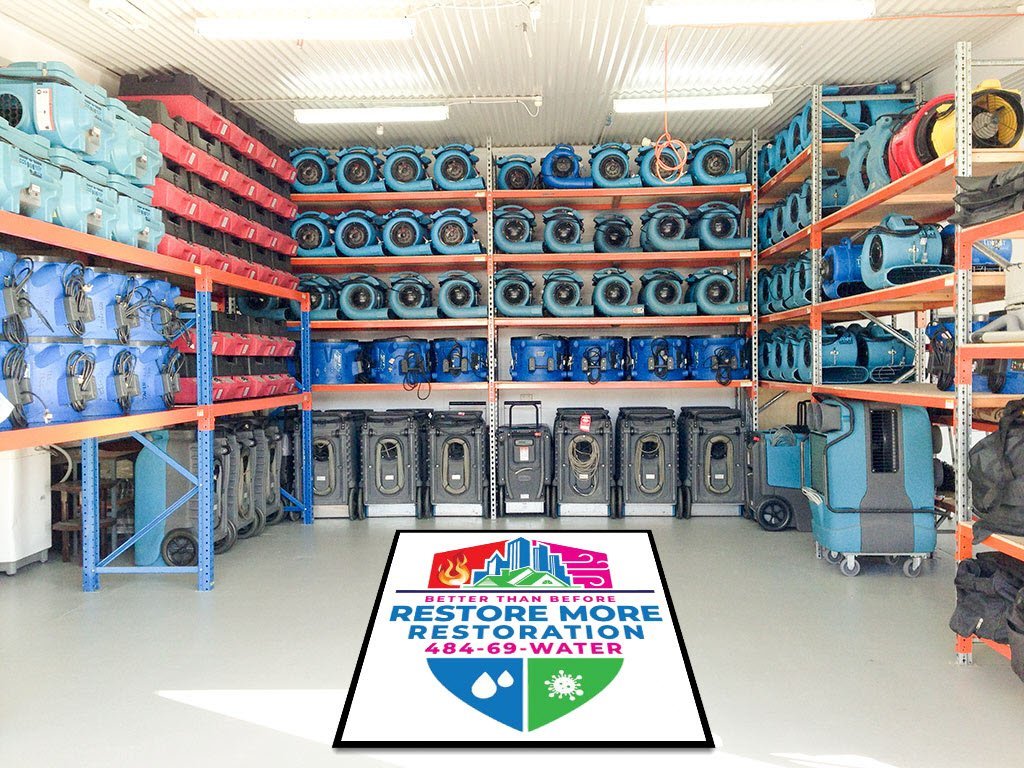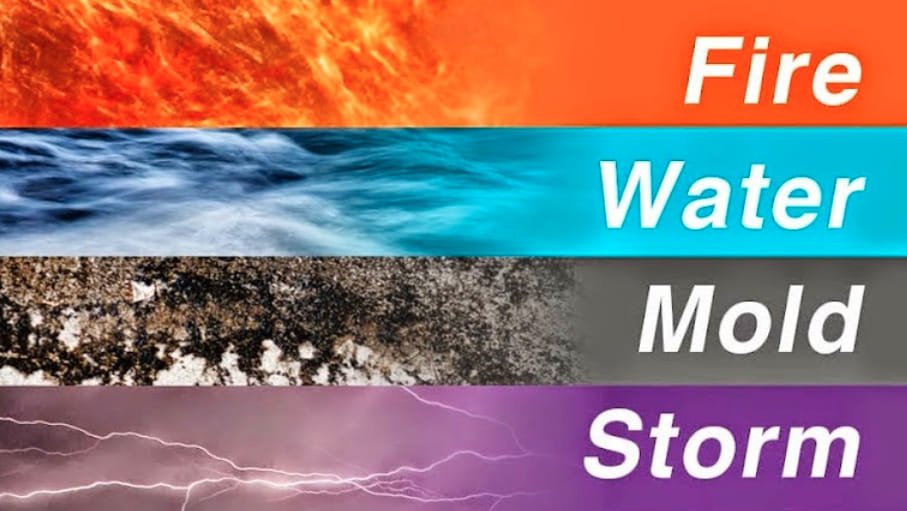Basement Water Damage Restoration in Garnet Valley, Pennsylvania
Basement water damage represents one of the most common and potentially devastating property issues facing Garnet Valley homeowners. Whether it’s a finished basement family room flooded by a burst pipe, a utility basement affected by sump pump failure, or groundwater intrusion during heavy rainfall, basement water damage requires specialized restoration approaches that address both immediate damage and long-term moisture control. The unique challenges of below-grade restoration demand expertise in basement-specific techniques, advanced drying methods, and comprehensive moisture management strategies.
At waterdamagecleanupgarnetvalleypa.com, we specialize in connecting Garnet Valley residents with expert basement water damage restoration services. Our trusted partner, RestoreMore365, brings extensive experience in basement restoration, combining advanced below-grade drying techniques with comprehensive moisture control strategies to restore your basement and protect your home’s foundation and structural integrity.
Understanding Basement Water Damage in Garnet Valley
Basement water damage in Garnet Valley presents unique challenges due to the area’s geography, soil conditions, climate patterns, and housing characteristics. According to the American Society of Home Inspectors, basement moisture problems affect millions of homes nationwide, with proper restoration and prevention being critical for maintaining structural integrity and indoor air quality.
Geographic and Environmental Factors
Delaware County Soil Conditions: Garnet Valley’s location in Delaware County features clay-rich soils that can retain moisture and create hydrostatic pressure against basement walls during wet periods. These soil conditions can contribute to basement water intrusion through foundation walls, floor joints, and other vulnerable areas.
Brandywine Creek Watershed: The area’s proximity to Brandywine Creek and its tributaries means that some properties may be subject to elevated groundwater levels during heavy rainfall or spring snowmelt, increasing the risk of basement flooding through foundation drainage systems.
Seasonal Weather Patterns: Garnet Valley experiences seasonal weather patterns that create specific basement water damage risks, including spring thaws that can overwhelm drainage systems, summer storms with heavy rainfall, and winter freeze-thaw cycles that can affect foundation integrity.
Topographic Considerations: The rolling topography of Garnet Valley means that some properties are located in lower-lying areas or have grading that directs surface water toward foundations, increasing basement water intrusion risks.
Common Basement Configurations in Garnet Valley
Understanding the different types of basements common in Garnet Valley helps explain the various restoration challenges and approaches:
Finished Basements: Many Garnet Valley homes feature finished basements that serve as family rooms, home offices, recreational areas, or additional bedrooms. These spaces often contain valuable furnishings, electronics, carpeting, and personal belongings that require specialized restoration techniques when water damage occurs.
Partially Finished Basements: Some homes have partially finished basements with finished areas for specific uses and unfinished areas for utilities and storage. These mixed-use spaces require restoration approaches that address both finished and unfinished areas appropriately.
Unfinished Utility Basements: Traditional unfinished basements house utilities, storage, and mechanical systems. While these spaces may seem less vulnerable to water damage, they often contain valuable equipment and stored items that require protection and restoration.
Walk-Out Basements: Some Garnet Valley properties feature walk-out basements that provide direct exterior access. These configurations can be more susceptible to water intrusion through doors, windows, and grade-level openings during severe weather events.
Crawl Spaces: While not technically basements, crawl spaces present similar moisture challenges and require specialized restoration approaches when water intrusion occurs.
Types of Basement Water Damage
Basement water damage can occur through various mechanisms, each requiring different restoration approaches:
Plumbing System Failures
Burst Pipes: Basement plumbing failures can cause rapid flooding with clean water that, while initially less hazardous than contaminated water, can quickly become problematic if not addressed immediately. Burst pipes in basements often affect large areas due to the confined space and gravity flow.
Water Heater Failures: Water heater failures can release 40-80 gallons of water rapidly into basement areas, often affecting finished flooring, stored items, and adjacent areas. These failures frequently occur without warning and can cause extensive damage before discovery.
Sump Pump Failures: Sump pump systems are designed to remove groundwater from basement areas, but when they fail during heavy rainfall or power outages, rapid basement flooding can occur. These failures often happen during the worst possible conditions when backup systems are most needed.
Sewage Backups: Sewage backups into basements create immediate health hazards and require specialized restoration approaches. These situations involve contaminated water that requires professional handling with appropriate safety protocols and specialized cleaning procedures.
Supply Line Failures: Water supply lines serving basement fixtures, laundry equipment, or utility systems can develop leaks or failures that cause ongoing water damage. These situations may develop gradually or occur suddenly, depending on the nature of the failure.
Foundation and Structural Water Intrusion
Hydrostatic Pressure: Groundwater pressure against foundation walls can force water through cracks, joints, or porous materials, creating basement water intrusion that may be ongoing or intermittent depending on groundwater levels and weather conditions.
Foundation Cracks: Settlement, freeze-thaw cycles, or other factors can create cracks in foundation walls or floors that allow water intrusion. These structural issues often require both immediate restoration and long-term repair solutions.
Window Well Flooding: Basement windows with inadequate drainage can allow water accumulation that leads to window leakage and basement flooding. These situations often occur during heavy rainfall when surface drainage systems become overwhelmed.
Floor Drain Backups: Basement floor drains can become overwhelmed during heavy rainfall or may back up due to municipal sewer system issues, causing basement flooding with potentially contaminated water.
Exterior Grading Issues: Improper grading that directs surface water toward foundations can cause basement water intrusion through various entry points, particularly during heavy rainfall events.
HVAC and Mechanical System Issues
Air Conditioning Condensate: Central air conditioning systems can produce significant amounts of condensate that, if not properly drained, can cause basement water damage. Blocked condensate drains or equipment malfunctions can lead to ongoing moisture problems.
Boiler and Heating System Leaks: Basement heating systems can develop leaks that cause water damage to surrounding areas. These situations may develop gradually and go unnoticed until significant damage has occurred.
Humidifier Malfunctions: Whole-house humidifiers can malfunction and cause water damage in basement mechanical areas. These situations often involve ongoing moisture that can create ideal conditions for mold growth.
Ductwork Condensation: Improperly insulated ductwork in basements can develop condensation problems that lead to water damage and moisture issues in surrounding areas.
Specialized Basement Restoration Techniques
Basement water damage restoration requires specialized techniques that address the unique challenges of below-grade environments:
Advanced Water Extraction for Basements
Truck-Mounted Extraction Systems: Powerful truck-mounted extraction units can remove large volumes of water quickly from basement areas, even when access is challenging. These systems can extract water through basement windows or other openings when direct access is limited.
Submersible Pump Systems: For severe basement flooding, submersible pumps can remove large volumes of water continuously, allowing restoration work to begin while extraction continues.
Portable Extraction Equipment: Portable extractors can access tight spaces, finished areas, and locations where larger equipment cannot reach, ensuring complete water removal from all affected areas.
Specialized Extraction Techniques: Different basement configurations require different extraction approaches, from finished basement carpet extraction to utility area water removal with equipment protection.
Below-Grade Drying Strategies
Basement-Specific Dehumidification: Basements require specialized dehumidification approaches that account for limited ventilation, potential vapor barriers, and the tendency for moisture to accumulate in below-grade environments.
Strategic Air Movement: Air movement in basements must be carefully planned to create effective drying conditions while preventing moisture migration to unaffected areas of the home.
Moisture Barrier Management: Existing moisture barriers and vapor retarders must be evaluated and potentially modified to optimize drying conditions while maintaining long-term moisture control.
Temperature Control: Basement drying often requires temperature management to optimize evaporation rates while preventing condensation in cooler below-grade environments.
Structural Drying for Basement Materials
Concrete and Masonry Drying: Basement foundations and floors require specialized drying techniques that account for the density and moisture retention characteristics of concrete and masonry materials.
Insulation Management: Wet insulation in basement walls and ceilings often requires removal and replacement, as it can retain moisture and create ongoing problems if not properly addressed.
Framing and Structural Elements: Basement framing materials require careful moisture monitoring and specialized drying techniques to prevent warping, rot, and structural damage.
Flooring System Restoration: Basement flooring systems, from concrete slabs to raised subfloors, require different restoration approaches depending on construction type and moisture penetration.
Basement-Specific Restoration Challenges
Basement restoration presents unique challenges that require specialized expertise:
Limited Access and Ventilation
Access Limitations: Basement access through narrow stairways or exterior entrances can limit equipment options and require specialized approaches for moving restoration equipment and materials.
Ventilation Challenges: Limited natural ventilation in basements requires mechanical ventilation systems to create proper drying conditions and maintain air quality during restoration work.
Ceiling Height Restrictions: Low basement ceilings can limit equipment placement and require specialized compact equipment designed for confined spaces.
Utility Coordination: Basement restoration often requires coordination around existing utilities, electrical systems, and mechanical equipment that cannot be easily relocated.
Contamination and Health Concerns
Mold Growth Potential: Basements’ naturally higher humidity and limited air circulation create ideal conditions for mold growth, requiring aggressive prevention measures during restoration.
Air Quality Management: Below-grade environments can trap contaminants and require specialized air quality management during restoration work to protect occupant health.
Cross-Contamination Prevention: Preventing contamination spread from basements to upper levels requires specialized containment and air pressure management techniques.
Chemical and Material Hazards: Basements often contain stored chemicals, paints, and other materials that can create additional hazards when exposed to water damage.
Structural and Long-Term Considerations
Foundation Impact Assessment: Basement water damage may indicate or cause foundation problems that require structural evaluation and potential repair beyond restoration work.
Moisture Control Integration: Effective basement restoration must integrate with long-term moisture control strategies to prevent recurring problems.
Insulation and Energy Efficiency: Restoration work must consider insulation replacement and energy efficiency improvements that may be necessary after water damage.
Future Prevention Planning: Basement restoration should include planning for future prevention measures that address the root causes of water intrusion.
Why RestoreMore365 Excels in Basement Restoration
RestoreMore365 brings specialized expertise in basement water damage restoration that addresses the unique challenges of below-grade environments:
Basement Restoration Expertise
Specialized Training: RestoreMore365 technicians receive specialized training in basement restoration techniques, including below-grade drying, moisture control, and contamination prevention specific to basement environments.
Advanced Equipment: The company maintains specialized equipment designed for basement restoration, including compact dehumidifiers, submersible pumps, and air movement systems optimized for confined spaces.
Structural Knowledge: RestoreMore365’s team understands basement construction techniques and can identify structural issues that may contribute to water damage or require attention during restoration.
Long-Term Solutions: The company focuses on restoration approaches that address both immediate damage and long-term moisture control to prevent recurring problems.
Comprehensive Basement Services
Emergency Response: 24/7 emergency response capability ensures that basement flooding receives immediate attention, critical for preventing extensive damage and mold growth in below-grade environments.
Complete Restoration: RestoreMore365 provides complete basement restoration services, from initial water extraction through final reconstruction and moisture control system installation.
Content Protection: Specialized techniques protect and restore basement contents, including stored items, recreational equipment, and valuable belongings that may be affected by water damage.
Insurance Coordination: Extensive experience with basement water damage insurance claims ensures that restoration work addresses all covered damage while meeting insurance company requirements.
Advanced Technology for Basement Restoration
Moisture Detection Technology: Advanced moisture detection equipment can identify hidden moisture in basement walls, floors, and structural elements that might not be apparent through visual inspection.
Thermal Imaging: Thermal imaging technology can identify moisture patterns and potential problem areas in basement environments where visual inspection may be limited.
Air Quality Monitoring: Continuous air quality monitoring ensures that basement restoration work maintains healthy indoor air quality throughout the process.
Documentation Systems: Comprehensive documentation systems provide detailed records of basement restoration work for insurance purposes and future reference.
Basement Water Damage Prevention Strategies
Preventing basement water damage requires understanding the specific risks and implementing appropriate protection measures:
Exterior Prevention Measures
Proper Grading: Ensuring that soil grades away from the foundation helps direct surface water away from basement walls and reduces hydrostatic pressure against foundations.
Gutter and Downspout Management: Properly functioning gutters and downspouts that direct water well away from foundations are critical for preventing basement water intrusion.
Window Well Maintenance: Regular cleaning and maintenance of basement window wells, including proper drainage and waterproofing, helps prevent water accumulation and intrusion.
Foundation Sealing: Professional foundation sealing and waterproofing can help prevent water intrusion through foundation walls and provide long-term protection against basement flooding.
Interior Prevention Systems
Sump Pump Systems: Properly installed and maintained sump pump systems provide critical protection against basement flooding from groundwater intrusion.
Backup Sump Pump Systems: Battery backup or water-powered backup sump pump systems provide protection during power outages when primary systems may not function.
Interior Drainage Systems: Interior perimeter drainage systems can collect and redirect groundwater before it enters basement living spaces.
Dehumidification Systems: Whole-house dehumidification systems help maintain appropriate humidity levels in basements and prevent moisture-related problems.
Maintenance and Monitoring
Regular Inspections: Regular basement inspections help identify potential problems before they become major water damage incidents.
Sump Pump Testing: Regular testing of sump pump systems ensures they will function properly when needed most.
Moisture Monitoring: Humidity and moisture monitoring systems can provide early warning of developing moisture problems.
Professional Assessments: Periodic professional assessments can identify potential vulnerabilities and recommend appropriate prevention measures.
Basement Restoration Process
RestoreMore365’s basement restoration process is designed to address the unique challenges of below-grade water damage:
Initial Assessment and Safety
Safety Evaluation: Comprehensive safety assessment addresses electrical hazards, structural concerns, and contamination risks specific to basement environments.
Damage Documentation: Detailed documentation of all basement damage, including moisture mapping and photographic evidence for insurance purposes.
Source Identification: Identifying and addressing the source of water intrusion to prevent ongoing damage during restoration work.
Restoration Planning: Developing a comprehensive restoration plan that addresses both immediate damage and long-term moisture control needs.
Water Extraction and Drying
Complete Water Removal: Thorough water extraction using appropriate equipment for basement configurations and access limitations.
Structural Drying: Specialized drying techniques for basement materials, including concrete, masonry, and below-grade framing systems.
Moisture Monitoring: Continuous monitoring of moisture levels throughout the drying process to ensure complete moisture removal.
Air Quality Management: Maintaining healthy air quality during drying through appropriate ventilation and filtration systems.
Restoration and Reconstruction
Material Removal and Replacement: Removing and replacing materials that cannot be effectively restored, including insulation, drywall, and flooring as necessary.
Structural Repairs: Addressing any structural issues identified during the restoration process, including foundation repairs or improvements.
System Restoration: Restoring or upgrading mechanical systems, electrical components, and plumbing as needed.
Final Reconstruction: Complete reconstruction of finished basement areas to pre-loss condition or better, incorporating improvements that enhance moisture resistance.
Prevention Integration
Moisture Control Systems: Installing or upgrading moisture control systems to prevent future water damage incidents.
Waterproofing Improvements: Implementing waterproofing improvements identified during the restoration process.
Monitoring System Installation: Installing monitoring systems that provide early warning of future moisture problems.
Maintenance Planning: Developing ongoing maintenance plans that help prevent future basement water damage.
Insurance Considerations for Basement Water Damage
Understanding insurance coverage for basement water damage helps ensure appropriate claim handling:
Coverage Evaluation
Policy Review: Reviewing homeowner’s insurance policies to understand coverage for different types of basement water damage, including sudden and accidental damage versus gradual damage.
Exclusion Understanding: Understanding common exclusions such as flood damage, seepage, and gradual damage that may affect basement water damage claims.
Additional Coverage Options: Evaluating additional coverage options such as flood insurance or service line coverage that may provide protection for basement water damage scenarios.
Claim Documentation
Comprehensive Documentation: RestoreMore365 provides detailed documentation of basement water damage, including moisture readings, photographic evidence, and detailed damage assessments.
Source Documentation: Documenting the source and cause of basement water damage to support insurance claim processing and coverage determination.
Restoration Documentation: Detailed documentation of all restoration work performed, including materials used and techniques employed.
Claim Advocacy
Insurance Coordination: RestoreMore365 works directly with insurance adjusters to provide technical information about basement restoration requirements and ensure appropriate coverage.
Scope Development: Helping develop appropriate scopes of work that address all necessary restoration while meeting insurance company requirements.
Claim Support: Providing ongoing support throughout the insurance claim process to ensure fair and efficient claim resolution.
Health and Safety Considerations
Basement water damage can create serious health and safety concerns that require professional management:
Immediate Health Hazards
Electrical Safety: Water in basements creates serious electrical hazards that require immediate professional assessment and management.
Contamination Risks: Basement water damage may involve contaminated water from sewage backups or other sources that require specialized handling.
Structural Safety: Water damage can affect structural elements and create safety hazards that require professional evaluation.
Air Quality Concerns: Basement water damage can create air quality problems that affect the entire home and require professional management.
Long-Term Health Considerations
Mold Prevention: Aggressive mold prevention measures are critical in basement environments where conditions favor mold growth.
Indoor Air Quality: Maintaining healthy indoor air quality throughout the restoration process and implementing long-term air quality management strategies.
Moisture Control: Implementing effective moisture control strategies that prevent ongoing health risks from excessive humidity or moisture problems.
Professional Safety Protocols
Personal Protective Equipment: RestoreMore365 technicians use appropriate personal protective equipment for basement restoration work, including respiratory protection and protective clothing.
Safety Training: Comprehensive safety training ensures that restoration work is performed safely in challenging basement environments.
Health Monitoring: Ongoing health monitoring ensures that restoration work doesn’t create additional health risks for property occupants.
Advanced Basement Restoration Technology
RestoreMore365 uses advanced technology specifically designed for basement restoration challenges:
Specialized Drying Equipment
Low-Profile Dehumidifiers: Compact dehumidifiers designed for basement environments with limited ceiling height and access restrictions.
Basement Air Movers: Air movement equipment designed for basement configurations and optimized for below-grade drying conditions.
Moisture Detection Systems: Advanced moisture detection equipment that can identify hidden moisture in basement walls, floors, and structural elements.
Environmental Control Technology
Air Scrubbing Systems: Advanced air filtration systems that maintain air quality during basement restoration work.
Negative Air Pressure Systems: Containment systems that prevent contamination spread from basements to upper levels of homes.
Climate Control Systems: Specialized climate control equipment that optimizes drying conditions in basement environments.
Monitoring and Documentation Technology
Wireless Monitoring Systems: Remote monitoring systems that provide continuous data on drying progress and environmental conditions.
Digital Documentation: Comprehensive digital documentation systems that provide detailed records of basement restoration work.
Thermal Imaging Technology: Advanced thermal imaging that can identify moisture problems and monitor drying progress in basement environments.
Conclusion
Basement water damage represents one of the most challenging restoration scenarios that Garnet Valley homeowners may face. The unique characteristics of below-grade environments, combined with the potential for extensive damage to valuable finished spaces and critical home systems, make professional basement restoration essential for protecting both immediate property values and long-term home integrity.
RestoreMore365’s specialized expertise in basement water damage restoration ensures that Garnet Valley residents receive the advanced techniques, specialized equipment, and comprehensive approaches necessary for effective basement restoration. Their understanding of basement-specific challenges, combined with advanced technology and proven restoration methods, provides the best possible outcomes for basement water damage situations.
When basement water damage occurs in your Garnet Valley home, don’t risk inadequate restoration that could lead to ongoing problems, structural damage, or health hazards. Trust the basement restoration specialists who understand the unique challenges of below-grade environments and can provide the comprehensive solutions necessary for complete restoration and long-term protection.
For more information about related services, visit our pages on emergency water damage, water damage restoration, storm damage cleanup, mold remediation, and our comprehensive FAQ section. These resources provide additional information about restoration processes and prevention strategies that can help protect your valuable Garnet Valley property.
Remember, basement water damage requires specialized expertise that addresses both immediate restoration needs and long-term moisture control. Trust RestoreMore365 for basement restoration services that protect your home’s foundation, your family’s health, and your property investment for years to come.




